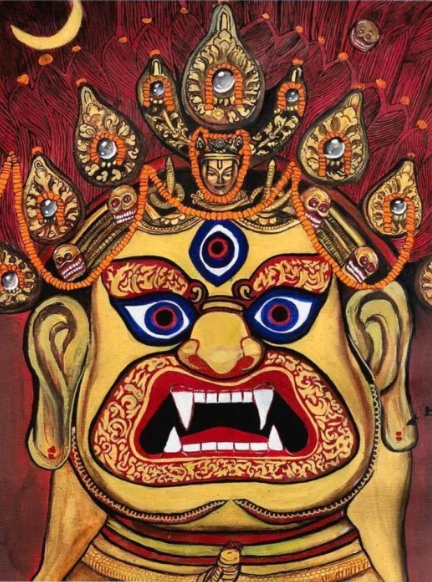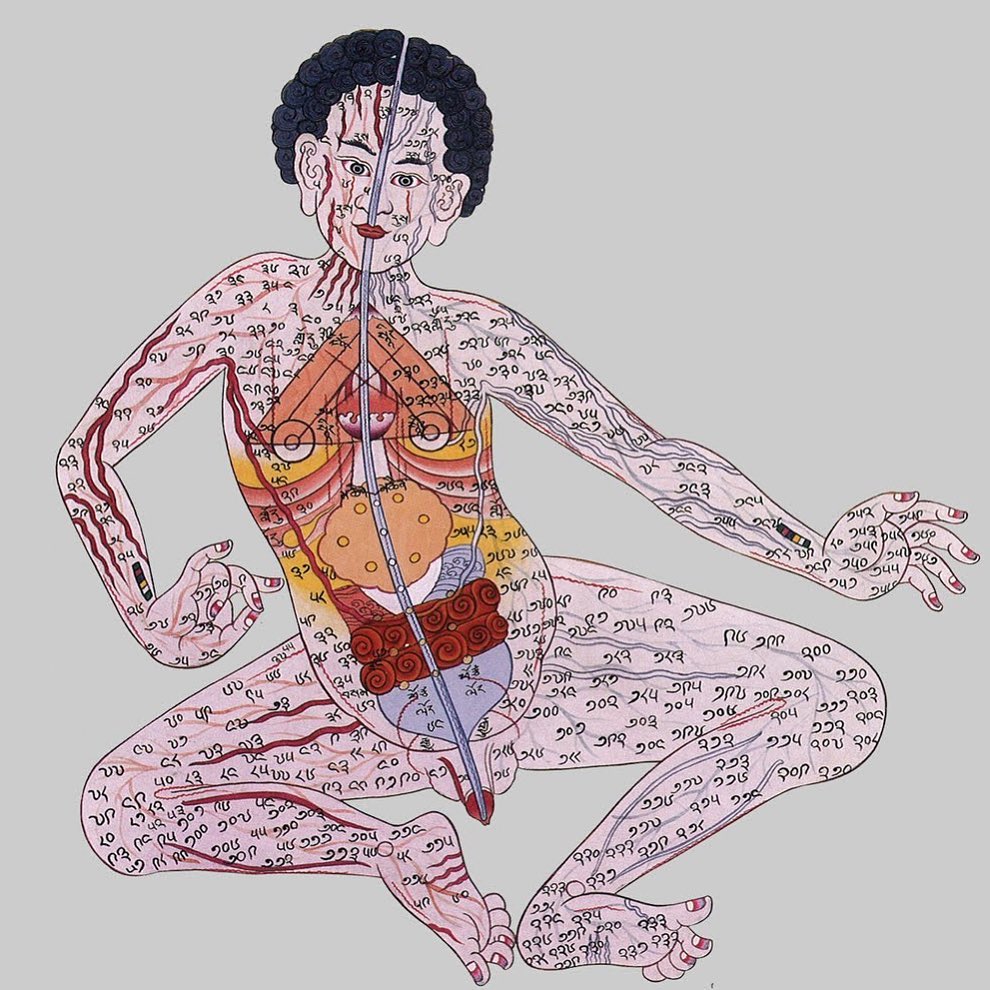Following up on several recent pieces posted in my Kundalini Awakening Support Group, speaking to a number of disparate, but inter-connected topics such as pranic healing, amrita (nectar), classical tantra in general, and practices for a safe and steady ascent, I’d like to put the spotlight on one particularly refined teaching known as the Vijnana Bhairava Tantra, or ‘The Scripture of the Bhairava who is Consciousness’. It’s a sacred scripture of the Trika lineage of classical Tantra, and is presented as a dialogue between the God and Goddess, most commonly known as Shiva and Shakti, but in this text known as Bhairava and Bhairavi.

“Bhairava means, the one who destroys fear, or is beyond fear. He is the fierce or frightening form of Śiva due to his Intensified Awareness, fully conjoined with its innate power of insight (Bhairavi). Vijnana means both consciousness and insight in this text. It refers to your consciousness—the aspect of your being that is present in all experiences from the subjective, first-person point of view.” Lakshmanjoo
“Shiva is known as ‘Bhairava’ because He brings about the [initial awakening that makes us] cry out in fear of remaining in the dreamstate—and due to that cry of longing he becomes manifest in the radiant domain of the heart, bestowing absence of fear for those who are terrified.” Kshemaraja
The scripture is composed of only 154 verses and, like most of the gold mine that is the Tantric corpus, wastes no time getting to the heart of the subject. Literally. Verses 1-4 read as follows:
(1) (The Goddess asks) “O Lord (/playful shining one), I have heard the entire teaching of the Trika that has arisen from our union, in scriptures of ever-greater essentiality, “I have heard everything that the energetic pulsations that have arisen from our union express in the form of scripture. I have heard all that, completely.”(2) but even now my doubts have not yet dissolved, Parameśvara. What is the true nature of Reality, O Lord?” (Transl. Wallis)
The VBT (Vijnana-Bhairava Tantra) is thought to have been compiled between the 6th to 9th centuries C.E.; it’s authorship is unknown, though the greatest sages of the Tantrik tradition have given us commentary on its sutras. But what sets the VBT in a class by itself is the style of its presentation. Written in 154 verses, 120 of these are systematic practices, methodically guiding the practitioner through 4 stages of engagement known as Upaya in the tradition, each to be engaged with according to the practitioner’s disposition and capacity.
Here is an example: Verse 24 gives us our first practice:
Verse 24: Dharana on the Two Generation Points
“Bhairava said, “Paradevi, whose nature is visarga, or creation, manifests as the upward prana, and the downward apana. By fixing the mind at the two points of generation (of prana and apana), the state of fullness results.” [pg.124 Vijnana Bhairava Tantra Ascent by Swamy Satyasangananda Saraswati]
I’m not a huge fan of this particular translation, and in a moment I’ll explain why, but for context, here is another translation for comparison:
“The Supreme Goddess constantly articulates (uccaret) as the life-giving flow of breath: prāṇa (exhale) rising up, and jīva (inhale)—the movement into embodiment—descending. By pausing at the two places where they arise, and filling those points [with silent awareness], one abides in the state of inner fullness (bharitā). ||24|| (Wallis)

I’m a stickler for word integrity, and the translator of the first example, though technically correct, especially when following up with several pages of commentary to clarify, leaves out a couple of important words, and is not familiar enough with English as a native language to make the verse nest in the western mind. That being said, for a beginner to these teachings, not only the commentary is needed to make sense of the verse, and the practice, but guidance from a teacher familiar and practiced in these means is highly recommended.
The practice itself is not difficult at all; that’s partly the reason why it’s first, but it’s also the most crucial starting point! It’s the base, and the basis for the entire series of practices, and honestly, if you get this one, all else would fall into place naturally. Another reason for presenting it here like this now.
The practice, simply put, is one of breath pause. The breath is paused at the lower and upper arcs of the inhalation-exhalation cycle. Many of you may be familiar with this practice of breath pause in the context of the hamsa mantra, or ham saha, hum (aham) referring to the I nature, the tendency for introversion, or inward repose (Shiva), and sah referring to the outward flow, or engagement with life (Shakti), outward orientation, creation, manifestation (Nivrtti | Pravrtti).
While much of this might be intuitive, you can see why further discourse and guidance might be required. A practice as simple as this, is also a primary practice of the Kula Kundalini Sadhana. Notice how both translations of the first verse reference the Goddess first. Well, Kundalini is just another name for this Goddess force, or nature. Mother Nature—the life force. Prana. In the first translation She manifests at the two points of visarga. In the second translation She articulates. She articulates because another name for the Goddess is Matrika. No, not as in matriculation, but close! She is the Word, by which creation, or reality, manifests. Food for another piece. But in this context, this practice would see Her rise.
From the Commentary of Swamy Satyasagananda on verse 24:
“Here the first Upaya, or practical method of dharana, is revealed. This Upaya can be treated either as an individual dharana or as part of a series of dharanas from (verses) 24 to 31 that leads to the experiencec of awakening, ascent and merging of Kundalini with Paramshiva. Awareness of the pranic flows is the medium for these preliminary dharanas. Thus, in order to understand this dharana it is necessary to know how the pranic flows are generated within the body, where their source is (ref. 72,000 nadis) and what functions they assume in the process of manifestation.”

Note: not only the nadis and channels, but familiarity with the five winds, vayus, i.e., essential pranayama is necessary in this context.
“Paradevi (Bhairavi, Shakti, Kundalini) is the transcendental energy which, as the sum total of all the energy in the universe, is responsible for creation or manifestation. This manifestation goes on all the time; it never stops. If it were to stop, life would come to an end. Pranashakti is one force, but it has many jobs to do…” (Hence, She has many names) (pgs 148-49)
Note: So, it should be further understood, that Kundalini does not sleep. She is much more than a snake coiled in the lower chakra. The chakras do not require activation. They are already activated. That is Her domain. To give you life.
The commentary continues for several pages, but skipping forward quite a bit, I found this next part pertinent in the light of several conversations happening here lately.
“The actual points of generation of prana and apana (upwards and downward flows) are at the (navel center), and at the (eyebrow center). But we can also say that the original generation point for both is at the bindu visarga, because the individual prana, which is unified and whole without any divisions or dualities, begins its descent to the lower centers from this point. During the descent, when it reaches manipura chakra, it emerges as prana and apana and begins to flow in opposite directions.
This idea is further emphasized by the Tantrik texts that speak of amrita, a very potent secretion, dripping down from bindu visarga, a point at the top back of the head. When amrita falls down into the body, it is consumed by the heat of the sun at the navel center, and becoming retas, it falls down further to the lower centers, causing decay and death. If the process is reversed through certain practices described in Tantra, the secretion can be redirected back upwards to the higher centers. Then the yogi experiences a quantum of higher energy which completely alters the awareness, allowing him to become conscious of the transcendental side of his nature.” (pgs 152-53)
Notes:
Visarga, in Sanskrit, literally translates to : (colon) the top and bottom point of punctuation.
Bindu Visarga, the top point, is sometimes equated with the pineal gland.
Retas, (रेतस्) generally referring to semen or generative fluid
So, the following is a point of consideration and discussion for the group. In Tantrik practice, we call this Bhavana. A point of consideration to feel into at length, cultivate insight over, deepen your own attention and expand your awareness. This is also a practice of Kundalini Sadhana.
※Why does the descent into retas cause decay or death?
Note: Amrita is the nectar of immortality, associated with unity, divine consciousness, and spiritual vitality. It originates at bindu visarga, which in the subtle body is linked to the moon center, coolness, and stillness. It represents pure, undisturbed awareness—a taste of liberation.
But as it descends, it is consumed by the sun at the manipura (navel) center, associated with agni (fire), transformation, digestion, ego, and individual will. As it gets “burnt,” the nectar loses its immortality—and becomes retas, the generative force that fuels material existence, sensuality, and physicality. This descent mirrors the soul’s descent into embodiment, or the fall into duality, ego, and mortality.

…is a Saiva Tantrika, Gyana Yogi and founder of Uma Maheshwara Yoga & Ayurveda. David has an MA in Semiotics, lives in Japan with his family and works as a coach in L & D, devoting his time to developing science-based tools and programs that help people reach the fullest potential of the human condition.
Discover more from REAL YOGA
Subscribe to get the latest posts sent to your email.


